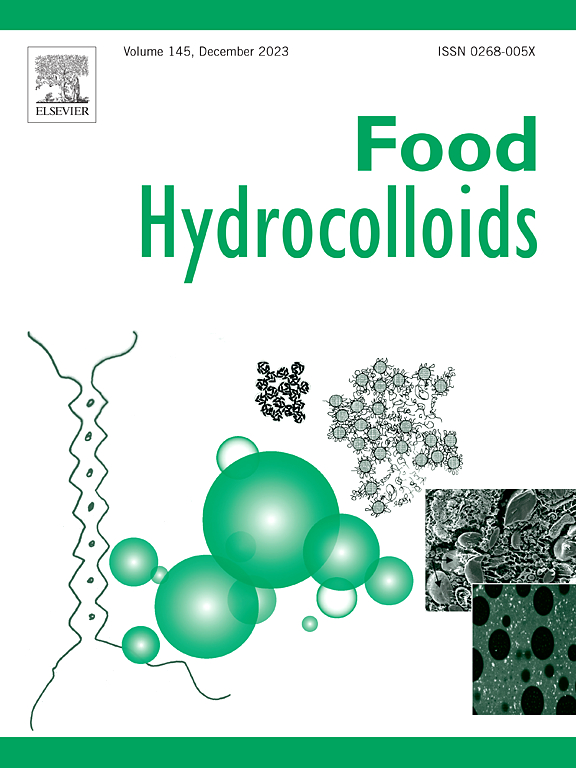Schiff's base crosslinked gelatin-dialdehyde cellulose film with gallic acid for improved water resistance and antimicrobial properties
IF 11
1区 农林科学
Q1 CHEMISTRY, APPLIED
引用次数: 0
Abstract
Gelatin is a versatile biopolymer for bio-packaging, but its poor water resistance and susceptibility to deterioration limit its application. This study addresses these limitations by forming a Schiff's base through crosslinking gelatin with dialdehyde cellulose (DAC) to enhance mechanical properties and water resistance. The crosslinking degree was investigated using the ninhydrin method and, also visually identified through a yellow-brown color formation. Crosslinking increased tensile strength (TS) from 30.2 ± 1.6 MPa to 37.3 ± 3.9 MPa and improved UV barrier properties, with a 30% increase in UV-B and UV-A protection compared to the pure gelatin film. Gallic acid (GA) was incorporated at concentrations ranging from 1% to 5% to improve the antimicrobial properties and shelf life of the film. Films with GA inhibited E. coli and S. aureus and resisted fungal growth on the film for more than 20 months. Furthermore, incorporation of GA further enhanced TS, elongation of break (EBA), barrier and hydrophobic properties of the composite film. The highest tensile strength was achieved with 3% GA (49.4 ± 4.5 MPa). EBA improved with higher GA concentrations, reaching a 44% improvement at 5% GA compared to the non-GA film. Oxygen permeability dropped from 5.7 ± 0.1 to 4.3 ± 0.1 cm3/m2 d 0.1 MPa, and water vapor permeability decreased from 6.7 ± 0.75 × 10−11 to 4.2 ± 0.07 × 10−11 g m/m2 s Pa at 5% GA. Despite these benefits, the films remained vulnerable to high acidic conditions. This study demonstrates that Schiff's base crosslinking of gelatin with DAC, combined with GA, results in durable, antibacterial bio-based packaging films with enhanced strength and barrier properties.

求助全文
约1分钟内获得全文
求助全文
来源期刊

Food Hydrocolloids
工程技术-食品科技
CiteScore
19.90
自引率
14.00%
发文量
871
审稿时长
37 days
期刊介绍:
Food Hydrocolloids publishes original and innovative research focused on the characterization, functional properties, and applications of hydrocolloid materials used in food products. These hydrocolloids, defined as polysaccharides and proteins of commercial importance, are added to control aspects such as texture, stability, rheology, and sensory properties. The research's primary emphasis should be on the hydrocolloids themselves, with thorough descriptions of their source, nature, and physicochemical characteristics. Manuscripts are expected to clearly outline specific aims and objectives, include a fundamental discussion of research findings at the molecular level, and address the significance of the results. Studies on hydrocolloids in complex formulations should concentrate on their overall properties and mechanisms of action, while simple formulation development studies may not be considered for publication.
The main areas of interest are:
-Chemical and physicochemical characterisation
Thermal properties including glass transitions and conformational changes-
Rheological properties including viscosity, viscoelastic properties and gelation behaviour-
The influence on organoleptic properties-
Interfacial properties including stabilisation of dispersions, emulsions and foams-
Film forming properties with application to edible films and active packaging-
Encapsulation and controlled release of active compounds-
The influence on health including their role as dietary fibre-
Manipulation of hydrocolloid structure and functionality through chemical, biochemical and physical processes-
New hydrocolloids and hydrocolloid sources of commercial potential.
The Journal also publishes Review articles that provide an overview of the latest developments in topics of specific interest to researchers in this field of activity.
 求助内容:
求助内容: 应助结果提醒方式:
应助结果提醒方式:


